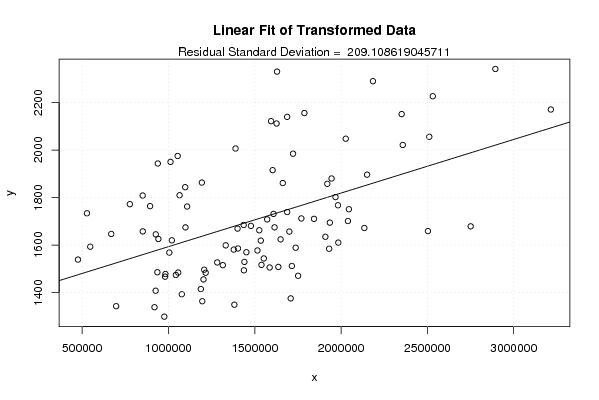Free Statistics
of Irreproducible Research!
Description of Statistical Computation | |||||||||||||||||||||||||||||||||||||||||||||
|---|---|---|---|---|---|---|---|---|---|---|---|---|---|---|---|---|---|---|---|---|---|---|---|---|---|---|---|---|---|---|---|---|---|---|---|---|---|---|---|---|---|---|---|---|---|
| Author's title | |||||||||||||||||||||||||||||||||||||||||||||
| Author | *The author of this computation has been verified* | ||||||||||||||||||||||||||||||||||||||||||||
| R Software Module | rwasp_boxcoxlin.wasp | ||||||||||||||||||||||||||||||||||||||||||||
| Title produced by software | Box-Cox Linearity Plot | ||||||||||||||||||||||||||||||||||||||||||||
| Date of computation | Tue, 11 Nov 2008 07:21:30 -0700 | ||||||||||||||||||||||||||||||||||||||||||||
| Cite this page as follows | Statistical Computations at FreeStatistics.org, Office for Research Development and Education, URL https://freestatistics.org/blog/index.php?v=date/2008/Nov/11/t1226413444tpsh2m96ijtvu62.htm/, Retrieved Sun, 19 May 2024 09:21:52 +0000 | ||||||||||||||||||||||||||||||||||||||||||||
| Statistical Computations at FreeStatistics.org, Office for Research Development and Education, URL https://freestatistics.org/blog/index.php?pk=23518, Retrieved Sun, 19 May 2024 09:21:52 +0000 | |||||||||||||||||||||||||||||||||||||||||||||
| QR Codes: | |||||||||||||||||||||||||||||||||||||||||||||
|
| |||||||||||||||||||||||||||||||||||||||||||||
| Original text written by user: | |||||||||||||||||||||||||||||||||||||||||||||
| IsPrivate? | No (this computation is public) | ||||||||||||||||||||||||||||||||||||||||||||
| User-defined keywords | |||||||||||||||||||||||||||||||||||||||||||||
| Estimated Impact | 125 | ||||||||||||||||||||||||||||||||||||||||||||
Tree of Dependent Computations | |||||||||||||||||||||||||||||||||||||||||||||
| Family? (F = Feedback message, R = changed R code, M = changed R Module, P = changed Parameters, D = changed Data) | |||||||||||||||||||||||||||||||||||||||||||||
| F [Box-Cox Linearity Plot] [Various EDA Topic...] [2008-11-11 14:21:30] [620b6ad5c4696049e39cb73ce029682c] [Current] | |||||||||||||||||||||||||||||||||||||||||||||
| Feedback Forum | |||||||||||||||||||||||||||||||||||||||||||||
Post a new message | |||||||||||||||||||||||||||||||||||||||||||||
Dataset | |||||||||||||||||||||||||||||||||||||||||||||
| Dataseries X: | |||||||||||||||||||||||||||||||||||||||||||||
1045,9 1401,9 1027,6 1703,8 1481,3 1422,7 1304,7 1246,1 1417,8 1459,1 1156,4 1304,5 1336,9 1372,3 975,5 1180,8 1361,3 1428,1 1355,9 1781,2 1697 1852 1844,1 1967,2 1747,1 1863,9 1559,3 1675 2237,5 1965,2 1871,5 1752,2 1360,7 1444,3 1621,6 1368 1553,9 1695,3 1397,1 1848,4 1809,2 1551,1 1546,6 1467,9 1662,4 1972,3 1673,5 1762 2019,8 1754,3 1400,4 1453,6 1740,9 1694,6 1541,2 1482,3 1632,1 1837,3 1797 2066,2 1983,8 1601,7 1660,3 1954 1991,9 1881,4 2345,5 1773,1 1719,2 2240,9 1816,4 2171,3 1823,3 2022,5 1991 1920 2168,4 2013,5 1790,8 1855,7 2074 2535,8 1837,2 1805,1 1785,7 2250 1959,7 1890,8 2405,7 2090,3 1666,5 1803,5 1793,8 1488,8 1545 1369,9 1451,6 | |||||||||||||||||||||||||||||||||||||||||||||
| Dataseries Y: | |||||||||||||||||||||||||||||||||||||||||||||
1593 1477,9 1733,7 1569,7 1843,7 1950,3 1657,5 1772,1 1568,3 1809,8 1646,7 1808,5 1763,9 1625,5 1538,8 1342,4 1645,1 1619,9 1338,1 1505,5 1529,1 1511,9 1656,7 1694,4 1662,3 1588,7 1483,3 1585,6 1658,9 1584,4 1470,6 1618,7 1407,6 1473,9 1515,3 1485,4 1496,1 1493,5 1298,4 1375,3 1507,9 1455,3 1363,3 1392,8 1348,8 1880,3 1669,2 1543,6 1701,2 1516,5 1466,8 1484,1 1577,2 1684,5 1414,7 1674,5 1598,7 1739,1 1674,6 1671,8 1802 1526,8 1580,9 1634,8 1610,3 1712 1678,8 1708,1 1680,6 2056 1624 2021,4 1861,1 1750,8 1767,5 1710,3 2151,5 2047,9 1915,4 1984,7 1896,5 2170,8 2139,9 2330,5 2121,8 2226,8 1857,9 2155,9 2341,7 2290,2 2006,5 2111,9 1731,3 1762,2 1863,2 1943,5 1975,2 | |||||||||||||||||||||||||||||||||||||||||||||
Tables (Output of Computation) | |||||||||||||||||||||||||||||||||||||||||||||
| |||||||||||||||||||||||||||||||||||||||||||||
Figures (Output of Computation) | |||||||||||||||||||||||||||||||||||||||||||||
Input Parameters & R Code | |||||||||||||||||||||||||||||||||||||||||||||
| Parameters (Session): | |||||||||||||||||||||||||||||||||||||||||||||
| Parameters (R input): | |||||||||||||||||||||||||||||||||||||||||||||
| R code (references can be found in the software module): | |||||||||||||||||||||||||||||||||||||||||||||
n <- length(x) | |||||||||||||||||||||||||||||||||||||||||||||

















